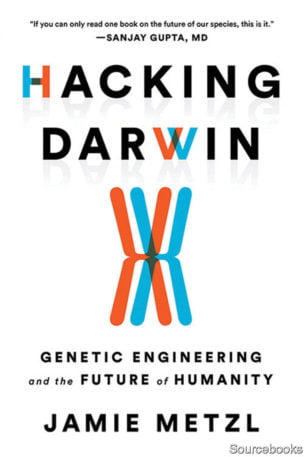A book excerpt and interview with Jamie Metzl, author of “Hacking Darwin”

By K.N.C.
NEW GENETIC technologies are exhilarating and terrifying. Society might overcome diseases by tweaking individual genomes or selecting specific embryos to avoid health problems. But it may also give rise to “superhumans” who are optimised for certain characteristics (like intelligence or looks) and exacerbate inequalities in society.
What is certain is that people will be able to make decisions about their lives in ways that were impossible in the past, when we relied more on random evolution than deliberation. In the words of Jamie Metzl, we are “Hacking Darwin,” the title of his latest book. It is a thoughtful romp through new genetic technologies, with insights on what it means for individuals, society and even great-power politics.
The theme draws together discrete strands of Mr Metz’s diverse background. He’s worked for the United Nations on humanitarian issues in Cambodia and served on America’s National Security Council under President Bill Clinton. He’s been an executive at a biotechnology company, a partner at large investment fund in New York and a candidate for Congress from Missouri. But perhaps even more relevantly, he is the author of two sci-fi novels on genetics, “Genesis Code” and “Eternal Sonata.”
As part of The Economist’s Open Future project, we asked Mr Metzl about genetic engineering, inequality and the new “liberal agenda”. Below the interview is an excerpt from his book, on the history of eugenics.
* * *
The Economist: What are the ways in which people are able to “hack Darwin” today and over the next 15 years or so?
Jamie Metzl: We have always fought against the inherent cruelty of natural selection, one of the two essential pillars of Darwinian evolution. We are now beginning to hack away at the second pillar, random mutation. Our growing understanding of how genes and biology function is opening the door to incredible medical applications like using genome sequencing and gene therapies to fight cancer and other diseases. But the healthcare applications of genetic technologies are only a station along the way to where these technologies are taking us.
Our ability to select embryos during in vitro fertilisation (IVF)—based on informed genetic predictions of both health-related traits and intimate characteristics like height, IQ and personality style—will grow over the coming years. We’ll use stem cell technologies to expand the number of eggs that prospective mothers can use in IVF and therefore the range of reproductive options for parents. We’ll deploy gene editing tools far more precise than today’s CRISPR systems to make heritable genetic changes to our future offspring. Over the coming decades, Darwin’s original concept of random mutation and natural selection will gradually give way to a process that is far more self-guided than anything Darwin could have imagined.
The Economist: Changing the nature of what it means to be human has huge consequences. What are the main ones?
Mr Metzl: We have internalised the idea that information technology is variable, which is why we expect each generation of our phones and computers to be better than the last. It’s harder for us to come to grips with the idea that our biology could be as variable as our IT, even though we understand intellectually that somehow we evolved from single cell organisms to complex humans over the past 3.8 billion years. Starting to see all of life, including our own, as increasingly manipulable will force us to think more deeply about what values will guide us as we begin altering biology more aggressively.
If we want to avoid dividing our species into genetic have and have-nots—a dangerous reduction in our diversity—or a genetic determinism that undermines our humanity, we’ll need to start living our values. But though we need to be mindful of the dangers, we must also keep in mind that these technologies have the potential to do tremendous good. Someday they might well help us avoid extinction level events like dangerous synthetic pathogens, a warmer climate, the fallout from a nuclear war or the eventual expiration of our sun.
The Economist: Do we have the ethical framework to handle this? If not, what might it look like if things go wrong?
Mr Metzl: We create beautiful art, philosophy and universal concepts like human rights but wipe out millions of each other in wars and genocides and still today invest massive amounts of our collective wealth in tools of mass murder. The “better angels of our nature” remain primary drivers in our development of genetic technologies, but the dark side of human nature could also be empowered through these same tools. We need a very strong ethical and cultural framework to increase the odds that we’ll use these technologies wisely, not least because access to them will be decentralised and democratised.
Although the positive possibilities far outweigh the negatives, it would be crazy to ignore the many ways things could go wrong. Like Icarus, we could fly too close to the sun and get burned if we hubristically assume we know more than we actually do. Our gene drives could crash ecosystems. We could use these tools to undermine our common identity as a species and social cohesion. The good news is that while the technologies are new, the values we’ll need to use them wisely are often old.
The Economist: What sort of regulations need to be in place to “enable” these technologies—and what rules should “constrain” them?
Mr Metzl: Genetic technologies touch the source code of what it means to be human and must be regulated. This job is all the more difficult because the technology is racing forward faster than the governance structures around them can keep up. On both the national and international levels, we’ll need enough governance and regulation to prevent abuses and promote public safety while not so much to impede beneficial research and applications.
To avoid dangerous medical tourism, every country should have a national regulatory system in place that aligns with international best practices and the country’s own values and traditions. We also have to start developing global norms that can ultimately underpin flexible international standards and regulations. These systems must be guided by core values rather than inflexible rules because what may now seem unthinkable, like actively selecting and even editing our future offspring, will increasingly become normalised over time. We urgently need to start preparing for what is coming.
The Economist: This takes the issue of human liberty to a new level (people should be free to change themselves or offspring), as well as the potential for unbridgeable inequalities (not just of wealth or life outcomes, but of capabilities encoded in oneself and family). How must the idea of liberalism adapt to address this? What does the “liberal agenda” look like for the 21st century vis-à-vis “hacking Darwin”?
Mr Metzl: If and when it becomes possible for some parents to give their children enhanced IQs, lifespans and resistance to disease, we will have to ask what this means for everyone else. Some will see these parents as first-adopters paving the way for everyone else, like the first privileged people buying smartphones. Others will call them usurpers laying the foundation for dangerously divided societies.
Whatever the case, differences within and between societies, fuelled by competition, will drive adoption of these technologies and present societies with stark choices. Too few regulations could lead to a dangerous genetic engineering free-for-all and arms race. But trying to ban genetic manipulations would increasingly require the trappings of the most oppressive police states. Some liberal societies may choose to provide a basic level of access to assisted reproduction and genetic-engineering services to everyone, not least to save the expense of lifetime care for people who would otherwise be born with preventable genetic diseases.
Societies already struggling to define the balance between the parental and state interests in the context of abortion will have an even tougher time drawing this line for parent-driven assisted reproduction. But if we thought the debates over abortion and genetically modified crops were contentious, wait until the coming debate over genetically modified people arrives. If we don’t want this to tear us asunder, we must all come together in a public process to figure out the best ways forward.
* * *
The disgraceful history of eugenics
Excerpted from “Hacking Darwin: Genetic Engineering and the Future of Humanity” by Jamie Metzl (Sourcebooks, 2019)
The term eugenics combines the Greek roots for good and birth. Although coined in the nineteenth century, the concept of selective breeding and human population culling has a more ancient history. Infanticide was written into Roman law and practiced widely in the Roman Empire. “A father shall immediately put to death,” Table IV of the Twelve Tables of Roman Law stated, “a son who is a monster, or has a form different from that of the human race.” In ancient Sparta, city elders inspected newborns to ensure that any who seemed particularly sickly would not survive. The German tribes, pre-Islamic Arabs, and ancient Japanese, Chinese, and Indians all practiced infanticide in one form or another.
The 1859 publication of Darwin’s The Origins of Species didn’t just get scientists thinking about how finches evolved in the Galapagos but about how human societies evolved more generally. Applying Darwin’s principles of natural selection to human societies, Darwin’s cousin and scientific polymath Sir Francis Galton theorized that human evolution would regress if societies prevented their weakest members from being selected out. In his influential books Hereditary Talent and Character (1885) and then Hereditary Genius (1889), he outlined how eugenics could be applied positively by encouraging the most capable people to reproduce with each other and negatively by discouraging people with what he considered disadvantageous traits from passing on their genes. These theories were embraced by mainstream scientific communities and championed by luminaries like Alexander Graham Bell, John Maynard Keynes, Woodrow Wilson, and Winston Churchill.

Although his work was partly in the spirit of the Victorian England times, Galton was then and even more now what we would call a racist. “The science of improving stock,” he wrote, “takes cognizance of all the influences that tend in however remote degree to give the more suitable races or strains of blood a better chance of prevailing speedily over the less suitable than they otherwise would have had.” In 1909, Galton and his colleagues established the journal Eugenics Review, which argued in its first edition that nations should compete with each other in “race-betterment” and that the number of people in with “pre-natal conditions” in hospitals and asylums should be “reduced to a minimum” through sterilization and selective breeding.
Galton’s theories gained increasing prominence internationally, particularly in the New World. Although eugenics would later accrue sinister connotations, many of the early adopters of eugenic theories were American progressives who believed science could be used to guide social policies and create a better society for all. “We can intelligently mold and guide the evolution in which we take part,” progressive theologian Walter Rauschenbusch wrote. “God,” Johns Hopkins economic professor Richard Ely asserted, “works through the state.” Many American progressives embraced eugenics as a way of making society better by preventing those considered “unfit” and “defective” from being born. “We know enough about eugenics so that if that knowledge were applied, the defective classes would disappear within a decade,” University of Wisconsin president Charles Van Hise opined.
In the United States, the “science” of eugenics became intertwined with disturbing ideas about race. Speaking to the 1923 Second International Congress of Eugenics, President Henry Osborn of New York’s American Museum of Natural History argued that scientists should:
“ascertain through observation and experiment what each race is best fitted to accomplish… If the Negro fails in government, he may become a fine agriculturist or a fine mechanic… The right of the state to safeguard the character and integrity of the race or races on which its future depends is, to my mind, as incontestable as the right of the state to safeguard the health and morals of its peoples. As science has enlightened government in the prevention and spread of disease, it must also enlighten government in the prevention of the spread and multiplication of worthless members of society, the spread of feeblemindedness, of idiocy, and of all moral and intellectual as well as physical diseases”.
Major research institutes like Cold Spring Harbor, funded by the likes of the Rockefeller Foundation, the Carnegie Institution of Washington, and the Kellogg Race Betterment Foundation, provided a scientific underpinning for a progressive eugenics movement growing in popularity as a genetic determinism swept the country. The American Association for the Advancement of Science put its full weight behind the eugenics movement through its trend-setting publication, Science. If Mendel showed there were genes for specific traits, the thinking went, it was only a matter of time before the gene dictating every significant human trait would be found. Ideas like these moved quickly into state policies.
Indiana in 1907 became the first U.S. state to pass a eugenics law making sterilization mandatory for certain types of people in state custody. Thirty different states and Puerto Rico soon followed with laws of their own. In the first half of the twentieth century, approximately sixty thousand Americans, mostly patients in mental institutions and criminals, were sterilized without their acquiescence. Roughly a third of all Puerto Rican women were sterilized after providing only the flimsiest consent. These laws were not entirely uncontroversial, and many were challenged in courts. But the U.S. Supreme Court ruled in its now infamous 1927 Buck v. Bell decision, that eugenics laws were constitutional. “Three generations of imbeciles,” progressive Supreme Court justice Oliver Wendell Holmes disgracefully wrote in the decision, “are enough.”
As the eugenics movement played out in the United States, another group of Europeans was watching closely. Nazism was, in many ways, a perverted heir of Darwinism. German scientists and doctors embraced Galton’s eugenic theories from the beginning. In 1905, the Society for Racial Hygiene was established in Berlin with the express goal of promoting Nordic racial “purity” through sterilization and selective breeding. An Institute for Hereditary Biology and Racial Hygiene was soon opened in Frankfurt by a leading German eugenicist, Otmar Freiherr von Verschuer.
Eugenic theories and U.S. efforts to implement them through state action were also very much on Adolf Hitler’s mind as he wrote his ominous 1925 manifesto, Mein Kampf, in Landsberg prison. “The stronger must dominate and not mate with the weaker,” he wrote:
“Only the born weakling can look upon this principle as cruel, and if he does so it is merely because he is of a feebler nature and narrower mind; for if such a law did not direct the process of evolution then the higher development of organic life would not be conceivable at all… Since the inferior always outnumber the superior, the former would always increase more rapidly if they possessed the same capacities for survival and for the procreation of their kind; and the final consequence would be that the best in quality would be forced to recede into the background. Therefore a corrective measure in favor of the better quality must intervene…for here a new and rigorous selection takes place, according to strength and health”.
One of the first laws passed by the Nazis after taking power in 1933 was the Law for the Prevention of Hereditary Defective Offspring, with language based partly on the eugenic sterilization law of California. Genetic health courts were established across Nazi Germany in which two doctors and a lawyer helped determine each case of who should be sterilized.
Over the next four years, the Nazis forcibly sterilized an estimated four hundred thousand Germans. But simply sterilizing those with disabilities was not enough for the Nazis to realize their eugenic dreams. In 1939, they launched a secret operation to kill disabled newborns and children under the age of three. This program was then quickly expanded to include older children and then adults with disabilities considered to have lebensunwertes leben, or lives unworthy of life.
Making clear the conceptual origins of these actions lay in scientifically and medically legitimated eugenics, medical professionals oversaw the murder of an ever-widening group of undesirables in “gassing installations” around the country. This model then expanded from euthanizing the disabled and people with psychiatric conditions to criminals and to those considered to be racial inferiors, including Jews and Roma, as well as homosexuals. It was not by accident that Joseph Mengele, the doctor who decided who would be sent to the gas chambers at Auschwitz, was a former star student of von Verschuer at the Frankfurt Institute for Hereditary Biology and Racial Hygiene.
By the mid-1930s, the American scientific community was pulling away from eugenics. In 1935, the Carnegie Institution concluded the science of eugenics was not valid and withdrew its funding for the Eugenics Records Office at Cold Spring Harbor. Reports of Nazi atrocities amplified by the 1945–46 Nuremberg trials put the nail in the coffin of the eugenics movement in the West. Although eugenics laws were finally scrapped from the books only in the 1960s in the United States and the 1970s in Canada and Sweden, very few people were forcibly sterilized after the war.
But as new technologies more recently began to revolutionize the human reproduction process and create new tools for assessing, selecting, or genetically engineering preimplanted embryos, many critics raised the specter of eugenics.
[…]
The parallels between the ugly eugenics of the late nineteenth century and the first half of the twentieth and what’s beginning to happen today are not insignificant. In both cases, a science at an early stage of development and with sometimes uncertain accuracy was or is being used to make big decisions—forced sterilization of the “feeble-minded” in the old days, not selecting a given embryo for implantation or terminating a pregnancy based on genetic indications today. In both cases, scientists and government officials seek to balance individual reproductive liberty with broader societal goals. In both cases, future potential children lose the opportunity to be born. In both cases, societies and individuals make culturally biased but irrevocable decisions about which lives are worth living and which are not. These parallels offer us a powerful warning.
But if we collectively paint all human genetic engineering with the brush of Nazi eugenics, we could kill the incredible potential of genetics technologies to help us live healthier lives. […] That there probably is an element of eugenics in decisions being made today on the future of human genetic engineering should push us to be careful and driven by positive values, but the specter of past abuses should not be a death sentence for this potentially life-affirming technology or the people it could help.
[…]
It’s not that hard to imagine future scenarios when humans would need to genetically alter ourselves in order to survive a rapid change in our environment resulting from global warming or intense cooling following a nuclear war or asteroid strike, a runaway deadly virus, or some kind of other future challenge we can’t today predict. Genetic engineering, in other words, could easily shift from being a health or lifestyle choice to becoming an imperative for survival. Preparing responsibly for these potential future dangers may well require we begin developing the underlying technologies today, while we still have time.
Thinking about genetic choice in the context of imagined future scenarios is, in many ways, abstract. But potentially helping a child live a healthier, longer life is anything but. Every time a person dies, a lifetime of knowledge and relationships dissolves. We live on in the hearts of our loved ones, the books we write, and the plastic bags we’ve thrown away, but what would it mean if people lived a few extra healthy years because they were genetically selected or engineered to make that possible? How many more inventions could be invented, poems written, ideas shared, and life lessons passed on? What would we as individuals and as a society be willing to pay, what values might we be willing to compromise, to make that possible? What risks would we individually and collectively be willing to take on? Our answers to these questions will both propel us forward and present us with some monumental ethical challenges.
___________
Excerpted from “Hacking Darwin: Genetic Engineering and the Future of Humanity.” Copyright © 2019 by Jamie Metzl. Used with permission of Sourcebooks. All rights reserved.
Source: https://www.economist.com
Disclaimer: We at Prepare for Change (PFC) bring you information that is not offered by the mainstream news, and therefore may seem controversial. The opinions, views, statements, and/or information we present are not necessarily promoted, endorsed, espoused, or agreed to by Prepare for Change, its leadership Council, members, those who work with PFC, or those who read its content. However, they are hopefully provocative. Please use discernment! Use logical thinking, your own intuition and your own connection with Source, Spirit and Natural Laws to help you determine what is true and what is not. By sharing information and seeding dialogue, it is our goal to raise consciousness and awareness of higher truths to free us from enslavement of the matrix in this material realm.
 EN
EN FR
FR

























